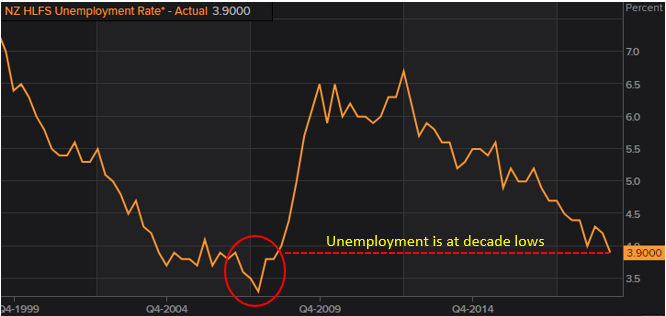*Expect cash rate on hold at 1.00%
*NZ economy ticking near full potential
*Markets to react to forward guidance
RBNZ expectations for Wednesday
Markets currently imply a 75% probability of no change to the official cash rate as we near Wednesday's 12pm AEST RBNZ monetary policy decision. It's unlikely that we'll see any change in September with the RBNZ having already taken out a 50bps insurance cut in the prior August meeting, slashing rates from 1.50% to 1.00% to the surprise of many. Rather, the large focus will be on forward guidance, and in particular, whether the RBNZ could undergo one more rate cut in November before the close of the year.
New Zealand economy operating close to potential
From the August monetary policy meeting, the RBNZ surprised with its insurance cut of 50bps in order to "continue to meet its employment and inflation objectives". The RBNZ noted that "absent of monetary stimulus [50bps rate cut], employment and inflation [were] likely to be below their targets over the medium term".
Looking across the data, it's clear RBNZ are in relatively healthy position and won't need to embark on any more rate cuts for the time being, with NZ employment near its maxium sustainable level (estimated by RBNZ) following August's unemployment print of 3.9% coming in well above expectations (4.3%). The last time the unemployment rate was this low came pre-GFC in Q2, 2008. Other data points in q/q job growth and q/q wages were also favourable beats.
With the next set of job statistics released
November 6, I'd expect the RBNZ November meeting to be more pressing than September's.

Source: Eikon
Low growth and inflation environment remain problematic
Areas of concern, however, that are likely to continue weighing on the minds of RBNZ members at this meeting is the persistent nature of low growth and inflation across domestic and international environments.
RBNZ said weak pricing behaviours, soft import inflation and subdued wage inflation have all contributed to "lower headline inflation despite increased labour and capacity pressures". While weak global growth driven by policy uncertainty and soft trading conditions have had spillover effects in the domestic economy and led to an easing of domestic growth. In light of this, on an absolute level, recent q/q GDP prints were above expectations though below RBNZ targets.
Reaction depends on RBNZ forward guidance
NZDUSD is trading at multi-year lows. Markets will likely take RBNZ hints demonstrating a propensity to ease come November as a bearish signal. In this case, look for markets to find support at 0.6233-44 (August/September 2015 lows). On the other side, should Governor Orr hold a more hawkish tone for the rest of 2019, it's not out of the question for NZDUSD to take out 0.63. Either way, forward guidance to be closely monitored throughout Wednesday's announcement.
Summary
Given the RBNZ's highly sensitive monetary policy function to global growth and international trading conditions, expect the official cash rate to remain accomodative in the near future. Should monetary stimulus seen in the RBNZ's 50bps insurance cut materially increase GDP growth, which is "necessary for inflation to increase to 2 percent and for employment to remain around max potential", 1.00% may mark the lowest point in the RBNZ's easing cycle. Though, having said that, the RBNZ have yet to rule out further rate cuts for the rest of the year. Risks still remain in forward GDP and employment prints, as well as, RBNZ speak.
Back